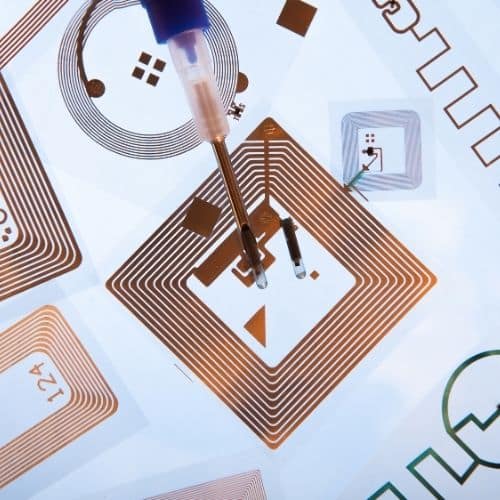In the past, asset tracking was largely manual and spreadsheet oriented. This meant that all updates would have to be logged onsite, and then later updated when there was access to a spreadsheet.
Then, asset tracking software took over. Asset tracking software, as it’s cloud-based, allows teams to share asset tracking operations between them. This means that it’s possible to scan and edit asset data with the equipment to hand. Then, these edits will be reflected across the board in real-time for your entire team to see.

Types Of RFID Asset Tags
Passive RFID Tags
If you’re using passive RFID asset tags, you’ll need to verify that they’re suited to certain materials as the lesser amounts of components can create issues with interference.
itemit’s standard passive RFID asset tags, for example, are optimised for metals, ceramic, and plastic. This way, you’ll be able to use them for IT asset management without risking interference. You can find out more about our asset labels by following the link.
Passive RFID tags are cheaper, as they have lesser functionality and fewer components than active tags. Passive tags work by bouncing an RF signal back to a reader via an embedded antenna, indicating the existence of the tag. Your asset tracking system will then be able to match up locations in the back-end, either via phone GPS data or the locations of your fixed readers.
Active RFID Tags
Your active RFID tags will also contain a battery, meaning that they can run out of charge. This is mitigated by functionality whereby an RF signal will “wake up” the tag, increasing the battery’s longevity.
The read-range is much more impressive than passive RFID tags as active tags can also emit a radio frequency with which RFID readers can interact with. The caveat to this is that these tags are often larger, as well as more expensive, meaning that they can be more difficult to conceal on your high-value assets.
How Do Asset Tags Fit In With RFID Asset Tracking Systems?
On your system, you’ll have an entire fixed asset register of unique asset profiles. This way, you’ll be able to add maintenance data, check in check out and booking dates, reminders, and ownership information against specific assets.
Asset tags are what speed up auditing and data-editing operations. As you’ll be able to log unique asset tag data, whether barcodes, QR codes, GPS trackers or RFID tags, your asset management system will be able to pair a digital profile with a physical asset.
Then, every time you scan an asset’s tag, the last seen location and the user who scanned the tag also updates in your system. This provides you with a neat audit trail of where all of your assets have been and who has been interacting with them.
RFID asset tags, overall, speed up these operations greatly and allow you to do more with asset tracking. You need to scan a QR code or barcode with your phone’s camera whereas, with an RFID asset label, you will use external hardware.
Types Of RFID Asset Tracking Systems
Both have separate benefits, so it’s difficult to compare which is better for your operations, but both are certainly an improvement upon QR code asset management.
Handheld RFID Reader-Based Systems
Therefore, this system is great within many verticals. For example, if you’re asset tracking in the healthcare industry, you’ll be able to scan RFID tags from a distance so as not to disrupt patients. Alternatively, if you’re tracking high-value collections, you’ll be able to hide RFID tags on your assets, meaning you don’t affect the quality or look of your paintings, wine, or equipment.
Another use case handheld RFID is incredibly helpful for is auditing with a large number of assets. As you can scan from a distance and without a line of sight, verifying that assets are where they should be is an instant process.
In other words, if you’re tracking your inventory of laptops or equipment and you want to add it to a room, you’ll be able to add all of the equipment to that location using itemit’s quick add feature. Simply log the room as a location and press “quick add”. Then, with your handheld RFID reader, all you have to do is hold down the trigger and itemit will detect the items and log the move.
After this, you’ll be able to use itemit’s asset audit feature. It works in a very similar way, simply pull the trigger and itemit will tell you which assets have been discovered and which haven’t.
Fixed RFID Asset Management
Fixed RFID asset tracking offers you total automation when it comes to tracking where your assets are on-site. You’ll be able to place your RFID readers in tactical locations in your building. Then, when an RFID tag crosses the reader’s RF field, your fixed reader will be able to detect the tag and which direction it’s moving in.
In practice, this revolutionises stock management and location monitoring, as it totally automates asset location tracking. If time savings are critical, for example in healthcare asset management, you’ll be able to see which equipment is in which location without the need for manual input or updates.
You can buy a fixed RFID reader set from our website, too, as itemit has created a world-first, off-the-shelf, easy to set up fixed RFID system.
How itemit’s Asset Tracking Software Integrates All Of This
Therefore, itemit’s RFID integration is to create an off-the-shelf system that can benefit all businesses. As it’s off the shelf and as no bespoke development or consultation is required, the set-up time is reduced from months to hours, and the costs are reduced massively.
What this means is that itemit is a system for large businesses that are already looking at fixed RFID systems and would otherwise spend tens of thousands at least to implement them, but it is also a system for SMEs in a way that was previously inaccessible due to these same cost barriers.
This means that it’s possible to track where your assets are wherever they are whenever they move, as you’ll be able to fill accountability gaps when assets are in transit with GPS asset tracking, while also automating location tracking within your business for fixed RFID asset management.
itemit removes the need for technical knowledge, lengthy implementation time, high costs, and lots of frustration with a streamlined app and effective web portal. This is why our system is award-winning and we’re certified RFID experts by Zebra technologies, world-leaders in RFID hardware and solutions.
To find out more about how itemit’s asset tracking system can help your business save time and money, you’ll be able to contact the team at team@itemit.com or over the phone on +44 (0) 1223 421611. You can also start your free trial by filling in the form below.

Try itemit
Choose a better way to track
your assets.
Start your free 14-day trial now!

Keep Learning
itemit Blog
Tips, guides, industry best practices, and news.
How to Implement Real-Time Asset Tracking Solutions: Guide with Professional Tips
[lwp_divi_breadcrumbs font_icon="5||divi||400"...
How To Conduct an Asset Audit: Program Guide
Our guide teaches you how to conduct an asset audit. It also provides best practices, processes, and recommendations for ensuring accurate asset tracking.
How Easy Is RFID Tracking?
Want to try RFID tracking but feeling a little anxious? Read this post now to discover just how easy it is to use an RFID aset tracking system!


